 |
Mantle
plume beneath Italy? No thanks |
|
|
|
Angelo
Peccerillo
Dipartimento
di Scienze della Terra, University of Perugia,
Piazza Università, 06100 Perugia, Italy
pecceang@unipg.it
 Click here to
download a PDF version of this webpage Click here to
download a PDF version of this webpage
|
Background
The idea that the
complex magmatism occurring around the Tyrrhenian
Sea results from a deep mantle plume dates back
to 1970 (e.g. Vollmer, 1976). This theory
was recently resurrected in a much revised form
by Gasperini et al. (2002), who suggest
that the entire compositional variation of Plio-Quaternary
magmatism in Italy results from mixing a HIMU-like
mantle plume and components of subduction origin.
In a joint paper
by myself and Lustrino, shortly to appear in
the forthcoming GSA book “Plates,
Plumes & Paradigms”, this
subject is fully discussed (for a PDF download
of our paper,
click
here). We accept the idea of mixing, as
do a wealth of previous papers, but we consider
the occurrence of a mantle plume beneath Italy
unlikely, and at best unnecessary.
A recent paper by
Bell et al. (2004) proposes a yet more
extreme and simplistic variant of the plume hypothesis.
These authors suggest that Tyrrhenian Sea magmatism
is related (and it is not clear what this means.
Does the magma come from the plume? Does the plume
trigger magmatism in the asthenosphere and lithosphere?)
to a large-scale asymmetric plume beneath the
Mediterranean region. This plume has lain at a
depth of 600 to 400 km for at least 30-35 Ma,
but may have begun its activity as early as 60-70
Ma. Although remote from the lithosphere, this
plume apparently has been able to open the western
Mediterranean basins, to determine, by rift-push
forces, the compressional forces responsible for
formation of the Apennine-Maghrebian chain, and,
of course, to generate (and it is not clear how)
the magmatism that has occurred during the last
60-70 My. According to this hypothesis, the diversity
of compositions encountered in Italian magmatism
is due to heterogeneity in the plume resulting
from entrainment of upper-mantle wall rocks during
ascent. The implication is that all the magmatism
comes from the plume and its surroundings, i.e.
from a depth of more than 400 km.
This hypothesis,
proposed by Bell et al. (2004), is based
essentially on two Sr-Nd-Pb isotope diagrams.
These show smooth trends which, as suggested in
numerous previous papers (e.g., D’Antonio
et al., 1996; Esperança and Crisci,
1995; Gasperini et al., 2002), indicate
mixing among three distinct and discrete end-members.
These are assumed to represent mantle plumes.
In my opinion,
the plume hypothesis, in particular this present
version, is a much worse explanation than subduction-related
models for the bulk of Italian magmatism. The
plume hypothesis stems from a very limited type
of evidence (mainly Sr-Nd-Pb isotopes) and ignores
many petrological and geochemical data which
characterise the first-order features of Italian
magmatism.
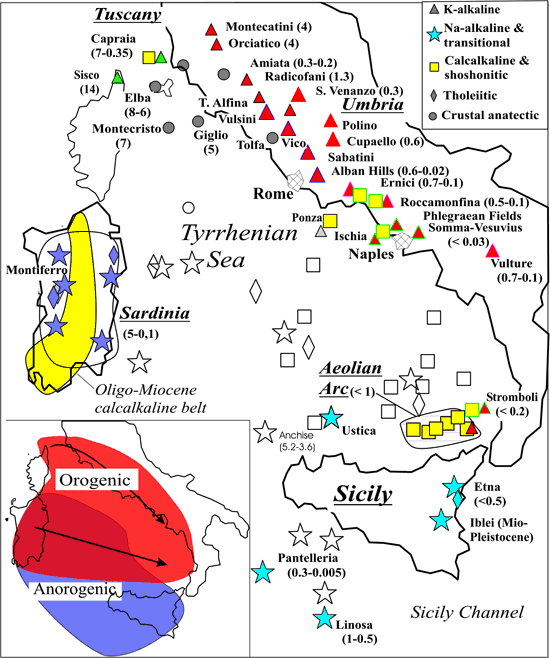
Figure 1. Schematic
diagram showing the distribution of Plio-Quaternary
magmatism in Italy. Inset: schematic distribution
of orogenic (i.e. high LILE/HFSE ratios) and unorogenic
(low LILE/HFSE ratios) volcanism. Arrows indicate
age variation for orogenic magmatism.
The potassic-alkaline
rocks represent the most important magma types
in central Italy. They show a wide range of potassium
enrichment and degree of silica saturation, from
nearly saturated shoshonites and ultrapotassic
lamproites to strongly undersaturated kamafugites
and Roman-type leucite-bearing rocks (Peccerillo,
2002, 2003). In spite of this, all show obvious
arc-type trace-element signatures with negative
HFSE anomalies and high LILE/HFSE ratios. Some
of the most mafic rocks from Tuscany (Mg# ~ 70-75;
Ni ~ 200-300 ppm, Cr ~ 500-700 ppm) range from
calc-alkaline to shoshonitic and ultrapotassic,
but all have incompatible element patterns with
negative HFSE anomalies. Interestingly, these
rocks, although obviously of mantle origin, resemble
very closely upper crustal material in both trace
elements and radiogenic isotopes (e.g.,
the Tuscany gneiss or the Dora Maira metagranites;
Figure 2). It has been demonstrated that these
rocks also resemble calc-alkaline-shoshonitic-ultrapotassic
rocks from the Western Alps, although the latter
are older (30 My; Peccerillo, 1999; Peccerillo,
2002).
In addition to rocks
with arc-type geochemical signatures, another
group of rocks shows intraplate compositional
characteristics. These range from tholeiitic to
Na-alkaline and nephelinitic, and have low LILE/HFSE
ratios. These rocks are subordinate to arc-type
rocks and are located either on the African plate
(e.g., at Iblei, Pantelleria and Etna)
or in back-arc positions with respect to the Apennine
compressional belt (e.g., Tyrrhenian
floor MORB- and OIB-like rocks, Sardinia Plio-Quaternary
magmatism).
From an isotopic
point of view, there is continuous variation in
Sr-Nd-Pb isotopes from southern Italy to Tuscany
and Sardinia. Rocks in the south (Etna, Iblei
and the Sicily Channel) have compositions intermediate
between DMM and HIMU. Rocks in Sardinia have compositions
close to EM1. Finally, the magmatism in the Italian
peninsula and the Aeolian arc shows intermediate
characteristics between Etna and Tuscany-Western
Alps composition. This has been highlighted by
several people, including Vollmer (1976),
Hawkesworth & Vollmer (1979), Vollmer
& Hawkesworth (1980) and many others.
In particular, D’Antonio et al.
(1996) and Gasperini et al. (2002) published
Pb vs. Sr and Nd isotopic diagrams similar to
those shown in Figure 1 of the recent paper by
Bell et al. (2004) in discussing the
isotopic variability of Italian magmatism. As
mentioned earlier, these authors pointed out that
the isotopic signatures reflect the mixing of
three end-members, as reiterated by Bell et
al. (2004). Gasperini et al. (2000)
suggest that only two of these end-members (HIMU-type
and EM1) are of plume origin and the other is
of subduction origin.
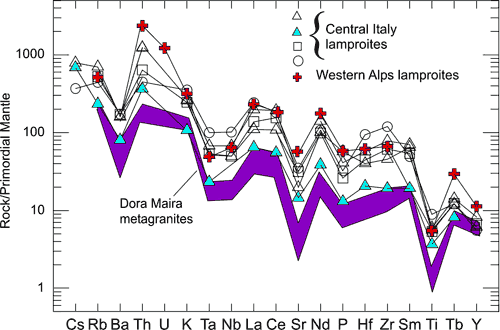
Figure 2. Incompatible
element concentrations normalised to mantle composition
for Tuscany mafic lamproites (Mg# > 75%; Ni
> 200 ppm; Cr > 500 ppm), Western Alps lamproites
and Dora Maira metagranites. Note the very similar
distribution patterns of mantle-derived lamproites
and upper crustal rocks such as Dora Maira metagranites.
For source of data see Peccerillo (1999). |
Subduction-related
vs. plume-related hypotheses for Italian magmatism
It is unlikely that
the complex magmatism in Italy is due to a single
type of process and related to a single type of
geodynamic setting (Peccerillo
& Lustrino, 2005). The various mantle
contamination and melt extraction events that
occurred at different stages of the evolution
of the area gave a very heterogeneous mantle.
Basically, all the rocks displaying arc-type compositional
signatures (e.g., calc-alkaline to shoshonitic
compositions, as well as potassic rocks from central
Italy) are directly related to mantle sources
modified by recent subduction processes during
convergenece between Africa and Europe (Doglioni
et al., 1999). In contrast, rocks with intraplate
compositions situated on the African plate or
in back-arc positions are probably generated by
melting mantle sources which have not been contaminated
by recent subduction.
There are several
variants of the subduction-related hypothesis
for orogenic Italian magmatism. However, all
these models agree that the arc-type Oligocene
to Quaternary magmatism in the Tyrrhenian Sea
area is genetically related to subduction of
the Adriatic and Ionian plates beneath the southern
European margin and by the eastward and south-eastward
migration of the subduction zone (Figures 3 & 4).
Such an hypothesis explains the occurrence of
widespread subduction-type magmatism, its age
variation from west to east, and the occurrence
of extensional basins in the Western Mediterranean,
due to back-arc opening (e.g., Doglioni
et al., 1997,
1999). The variable compositions of orogenic
magmas (in both trace elements and radiogenic
isotopes) are basically related to different
types of subducted material being added to mantle
sources. For example, the calc-alkaline volcanism
of Sardinia (32 to 15 Ma) and of the southern
Tyrrhenian Sea is interpreted as the consequence
of subducting oceanic-type crust. In contrast,
the volcanism in central Italy is related to
subduction of a continental-type Adriatic plate.
The crust-like trace element patterns and radiogenic
isotope compositions of magmas from central
Italy obviously suggest the addition of crustal
material to the mantle, a process which can
be accomplished easily by subduction processes.
The possibility that continental crust can be
subducted to great depths (more than 100-120
km) within the upper mantle is demonstrated
by very high pressure metamorphism of rocks
in some orogenic areas, e.g., the Dora
Maira Massif of Western Alps.
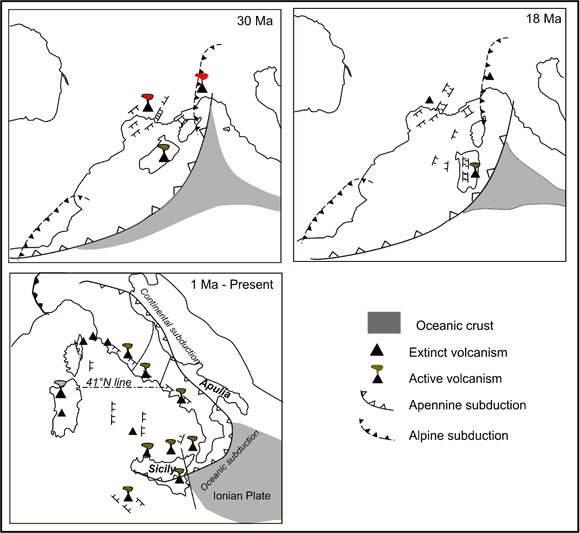
Figure 3. Schematic
model of the evolution of the Western Mediterranean
and the Tyrrhenian Sea from Oligocene to Present.
Simplified after Carminati et al. (1998) and Cavazza
& Wezel (2003).
Subduction-related
hypotheses also provide a satisfactory explanation
for:
-
Deep seismicity
beneath the eastern Aeolian arc, which defines
a steep Benioff zone extending to a depth
of about 500 km up to the Vesuvius area; this
is generated by subduction of the Ionian plate.
-
The occurrence
of a vertical rigid body cutting the asthenosphere
beneath the Apennine chain, interpreted as
a remnant of a young subduction zone (Panza
et al., 2003);
-
The occurrence
of a belt of cold mantle around the Apennine-Maghrebian
chain revealed by tomographic studies, which
suggests recent introduction of cold material
into the upper mantle (Wortel & Spakman
2000; Piromalli & Morelli 2003).
All the above features
are ignored by the plume-related hypotheses
proposed by Bell et al. (2004). Calc-alkaline
rocks are mentioned only once or twice throughout
the paper. It is ignored that the potassic and
ultrapotassic rocks of central Italy also have
arc-type geochemical characteristics and some
of the northern occurrences have incompatible
element patterns and radiogenic isotope signatures
which resemble closely the upper crust. This
holds also for kamafugites and for the so-called
carbonatites . Therefore, all this magmatism
is geochemically and isotopically different
from the equivalent rocks from intracontinental
rifts, as discussed by now in hundreds of papers.
If a deep plume is the explanation (the source?)
for Italian magmatism, why do the majority of
volcanic rocks have arc signatures and why do
the ultrapotassic rocks have crust-like geochemical
and isotopic compositions? What processes imparts
on deep plume material a geochemical and isotopic
composition identical to upper crustal rocks?
If the observed magmas represent old crust recycled
through the deep mantle and then sampled by
a plume, is it credible that the geochemical
characteristics of upper crustal material have
been preserved throughout such a long journey
through the Earth without appreciable element
fractionation? Additional
objections to the plume hypothesis include the
implausibility that such a body, stalled at
600-400 km depths for tens of millions of years,
could generate lithospheric extension of several
hundreds of km (some 600 km west-east, along
with north-south Europe-Africa covergence of
about 120 km), the absence of large-volume LIP-type
magmatism, and the presence of a rigid instead
of a soft layer at about 400 km, to mention
but a few.
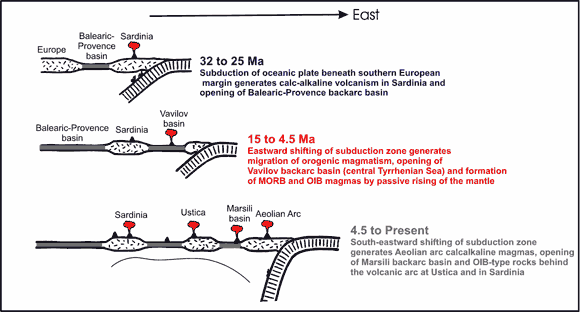
Fig. 4. Section
across the Tyrrhenian Sea showing eastward and
south-eastward migration of the subduction zone
and orogenic magmatism, along with dyachronous
opening of backarc basins. Click
here for enlargement.
In conclusion, although
subduction-related hypotheses, as with any other
scientific hypothesis, still present unanswered
questions, they do explain several primary compositional
features and the age and distribution of orogenic
magmatism in Italy. They also explain the occurrence
of rocks with anorogenic signatures, which would
be formed during passive upwelling in the lithosphere-asthenosphere
in the extensional zones (e.g., along
strike-slip faults and in back-arc areas) between
the converging European and African plates. |
So, why
a plume?
The main argument presented by Bell et
al. (2004) in favour of a mantle plume
origin for Italian magmatism is the large and
continuous Sr-Nd-Pb isotope variation in Italian
rocks. They suggest that these isotopes form
smooth trends requiring mixing between three
distinct and discrete end-members: FOZO, EM1
and a third end-member which they call ITEM
(Italian Enriched Mantle). The FOZO composition
(first invoked by Hoernle et al., 1996
but rejected by Gasperini et al., 2002)
is represented by Sicilian rocks (Etna, Iblei
and Pantelleria); the EM1 composition is represented
by Sardinian Plio-Quaternary rocks (Gasperini
et al., 2000; Lustrino et al.,
2000). The ITEM end member closely resembles
the upper crust, as has been repeatedly mentioned
in recent years (Peccerillo, 1999,
2002, 2003). The only new point is the acronym.
The objection that isotopic compositions do
not necessarily indicate mantle plumes has been
discussed widely (see several papers in the
forthcoming GSA book “Plates,
Plumes & Paradigms”) and
will not be reiterated here. I emphasise that
the interpretation of a complex province such
as the Italian magmatic province cannot be understood
by studing only two diagrams. Any petrogenetic
hypothesis must be able to explain all the petrological
data, something that the plume hypothesis cannot
do.
Isotopic variation in mafic Italian volcanics
is not smooth if looked in detail. In Figure
5 I use my own database of mafic rocks to enlarge
parts of the Sr-Nd-Pb isotope diagrams. It is
clear that there are many possible trends which
I have indicated by arrows. Whatever their significance,
these multiple trends do not support a model
of simple mixing between three end-members.
Rather they concur with trace element data in
indicating multiple mantle contamination events
(see Peccerillo, 1999).
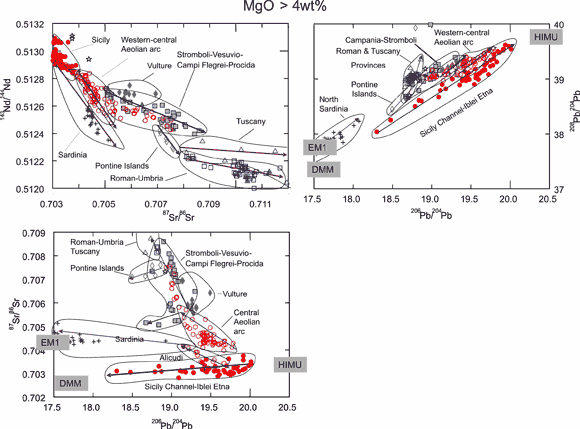
Figure 5. Detailed Sr-Nd-Pb
isotope diagrams for Plio-Quaternary Italian
mafic volcanics. Click
here for enlargment.
|
Conclusions
The plume hypothesis
is inadequate to explain the compositional complexities
of Italian magmatism. There is much more supporting
evidence for a model involving subduction than
for a plume. The plume hypothesis is based on
limited use of a few radiogenic isotopes. As Bell
et al. (2004) recognise, isotopic data reflect
sources rather than processes. In spite of this,
they apply these data to build a global geodynamic
and petrogenetic hypothesis for a very complex
area.
The hypothesis
of Bell et al. (2004) is a new variant
of an old idea dating from the early 1970s.
New ideas (or even new variants) are always
welcome, but the plume model for Italy is
not new. Furthermore, new ideas are not necessarily
better simply because are new. An important
prerequisite of a good new hypothesis is
that it must explain the data better than
older hypotheses. This is not the case for
the variants of the plume hypothesis proposed
by Bell et al. (2004). |
-
Bell K, Castorina
F, Lavecchia G, Rosatelli G, Stoppa F (2004)
Is there a mantle plume below Italy? EOS
85:541-547
-
Carminati
E, Wortel MJR, Spakman W, Sabadini R (1998)
The role of slab detachment processes in the
opening of the western-central Mediterranean
basins: some geological and geophysical evidence.
Earth Planet Sci Lett 160:651-665
-
Cavazza W,
Wezel FC (2003) The Mediterranean region.
A geological primer. Episodes 26:160-168
-
Esperança
S, Crisci GM (1995) The island of Pantelleria:
a case for the development of DMM-HIMU isotopic
compositions in a long-lived extensional setting.
Earth Planet Sci Lett 136:167-182
-
D’Antonio
M, Tilton GR, Civetta L (1996) Petrogenesis
of Italian alkaline lavas deduced from Pb-Sr-Nd
isotope relationships. In: Basu A, Hart SR
(eds) Isotopic Studies of Crust-Mantle
Evolution. Am Geophys Un Mon 95:
pp 253-267
-
Doglioni C,
Gueguen E, Sabat F, Fernandez M (1997) The
western Mediterranean extensional basins and
the Alpine Orogen. Terra Nova 9:109-112
-
Doglioni C,
Harabaglia P, Merlini S, Mongelli F, Peccerillo
A, Piromallo C (1999) Orogens and slabs vs.
their direction of subduction. Earth Sci
Review 45:167-208
-
Gasperini
D, Blichert-Toft J, Bosch D, Del Moro A, Macera
P, Télouk P, Albarède F (2000)
Evidence from Sardinian basalt geochemistry
for recycling of plume heads into the Earth's
mantle. Nature 408:701-704
-
Gasperini
D, Blichert Toft J, Bosch D, Del Moro A, Macera
P, Albaréde F (2002) Upwelling of deep
mantle material through a plate window: evidence
from the geochemistry of Italian basaltic
volcanics. J Geophys Res 107:
B12, 2367, doi:10.1029/2001JB000418
-
Hawkesworth
CJ, Vollmer R (1979) Crustal contamination
vs. enriched mantle: 143Nd/144Nd
and 87Sr/86Sr evidence
from the Italian volcanics. Contrib Mineral
Petrol 69:151-165
-
Hoernle K,
Behncke B, Schmincke H-U (1996) The geochemistry
of basalt from the Iblean Hills (Sicily) and
the Island of Linosa (Strait of Sicily): evidence
for a plume from the lower mantle. Goldschmidt
Conf, J Conf Abstr 1:264;
www.the-conference.com/JConfAbs/1/264.html
-
Lustrino M,
Melluso L, Morra V (2000) The role of lower
continental crust and lithospheric mantle
in the genesis of Plio-Pleistocene volcanic
rocks from Sardinia (Italy). Earth Planet
Sci Lett 180:259-270
-
Panza GF,
Pontevivo A, Chimera G, Raykova R, Aoudia
A (2003) The lithosphere-asthenosphere: Italy
and surroundings. Episodes 26:169-174
-
Peccerillo
A (1999) Multiple mantle metasomatism in central-southern
Italy: geochemical effects, timing and geodynamic
implications. Geology 27:315-318
-
Peccerillo
A (2002) Plio-Quaternary magmatism in central-southern
Italy: a new classification scheme for volcanic
provinces and its geodynamic implications.
In: Barchi RM, Cirilli S, Minelli G (eds)
Geological and geodynamic evolution of
the Apennines. Boll Soc Geol It Spec Vol
1: 113-127
-
Peccerillo
A (2003) Plio-Quaternary magmatism in Italy.
Episodes 26:222-226
-
-
Piromallo
C, Morelli A (2003) P wave tomography of the
mantle under the Alpine-Mediterranean area.
J Geophys Res, 108,
2065, doi: 10.1029/ 2002JB001757
-
Vollmer R
(1976) Rb-Sr and U-Th-Pb systematics of alkaline
rocks: the alkaline rocks from Italy. Geochim
Cosmochim Acta 40:283-295
-
Vollmer R,
Hawkesworth CJ (1980) Lead isotopic composition
of the potassic rocks from Roccamonfina (south
Italy). Earth Planet Sci Lett 47:91-101
-
Wortel MJR,
Spakman W (2000) Subduction and slab detachment
in the Mediterranean-Carpathian region. Science
290:1910-1917
For additonal references and data on Italian
Plio-Quaternary magmatism see:
http://www.unipg.it/~pecceang
|
last updated
6th April, 2005 |
|
|
|
